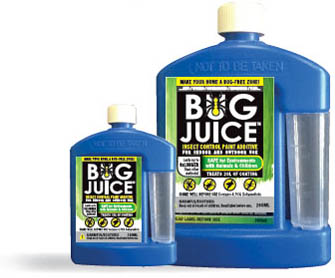Bug Juice™ kills crawling and flying insects on contact with treated surfaces
What is Bug Juice™?
Bug Juice™ is a remarkable insecticide paint additive designed to eliminate crawling and flying insects on most painted surfaces.

Where can Bug Juice™ be applied?
Bug Juice can be applied on most most painted surfaces, including kitchens and pantries.
Does Bug Juice™ repel bugs?
No, Bug Juice does NOT repel insects. It is a contact pesticide and it begins to work after an insect makes contact with the treated surface.
How long does Bug Juice™ last?
Bug Juice™ will last up to 4 years depending on where it is applied..
What type of coating can Bug Juice™ be mixed with?
Bug Juice™ can be added to any oil or latex ( water) based paint, stain or sealant.
Will it affect the appearance of the finish?
Bug Juice™ will not affect the colour or drying time of the coating it is
mixed with. Plus, Bug Juice™ is completely odourless!
What maintenance is involved?
It is recommended that you clean the
treated surface with water twice a year.
This provides a clean surface for
insects to land on.
How do I use Bug Juice™?
Simply mix Bug Juice™ into the paint or stain at the
recommended level and stir then apply the coating
as you would normally.
What insects does Bug Juice™ kill?
Cockroaches, ants, mosquitoes,flies, spiders,
silverfish, weevils and many other crawling and
flying insects.
How does Bug Juice™ work?
As an insect lands or crawls on a treated surface
the feet of the insect absorb the active ingredient.
(Through a sticky membrane that allows insects to cling to walls etc)
How long will it take to kill insects?
Most insects will die within 24 hours of contact with
the treated surface.
Will Bug Juice™ affect pets?
No, Bug Juice™ will not harm pets or birds.
Is Bug Juice™ safe?
Yes, when the treated surface is dry Bug Juice™ has
toxicity rating similar to an aspirin and a ph of 6.
(Saliva has the same rating)
Does the active ingredient seep out of the
painted surface?
No, the active ingredient is only released when an
insect makes contact with the treated surface and will not affect humans.
Do I need to apply Bug Juice™ in the primer or first
coat as well as the top coat?
No, use Bug Juice™ only in the top coat.
Are there any paints I can’t mix Bug Juice™ with?
The only paints you can’t mix Bug Juice™ with are
Epoxy based paints. (Normally used in industrial
applications)
Will Bug Juice™ prevent insect nesting?
Yes, unlike insect repellents Bug Juice™ kills the
insects so they cannot nest and reproduce.
Once I have mixed Bug Juice™ with the coating how
long should I take to use the coating?
It is recommended that the mixture is used within
5 hours of mixing with the coating otherwise the
insecticide will lose its effectiveness.
Can I use all methods of application when using
Bug Juice™ treated coatings?
You can use brushes and rollers but it is not
recommended to use Bug Juice with spray
equipment.
Is there anywhere I shouldn’t use Bug Juice™?
Do not apply to Formica® or plastic or other similar surfaces.
Is this product harmful to bees?
Generally bees don't tend to alight on painted surfaces much or for too long because they're foraging for pollen. Bug Juice™ is designed to focus on insects that tend to walk across or sit on painted surfaces, such as ants and spiders. It isn’t generally a product you would use on beehives, although some beekeepers have problems with ants invading their hives so coating the base of the hive could be an option to target ants provided that bees won’t come in contact with the treated surface. If bees alight for long enough on a surface treated with Bug Juice™ then it will affect them as it would other insects.
Over two decades ago (1982), Walla Walla Environmental registered the first ever insecticide paint additive. This paint additive, CPF (USEPA #47332-1) was a Chloropyrifos-based insecticide. Then in 1988, the second generation insecticide paint additive was registered. This Diazinon based insecticide, which was registered under the name CPF 2D (USEPA 47332-4) stayed on the market through 2000. These organophosphate-based insecticides were used for this type of application for nearly two decades. However, in 2000 the USEPA removed Diazinon as an insecticide paint additive.
Realising the direction the USEPA was heading, Walla Walla Environmental began studies in 1988 for a new replacement insecticide paint additive that also included an interior application.
This culminated in the registration of Bug-Juice Insecticide Paint Additive (USEPA 47332-11), which is a synthetic pyrethroid. This new product offered the consumer what they were looking for - an insecticide paint additive that can be used on most painted surfaces. The following is a brief summation of studies used to ascertain the efficacy of this insecticide when formulated with latex paints after application. Each study protocol called for one control and five replicates. One replicate used 15 nymphs, all others had a minimum of 10 participants in each replicated and the control. All standards were untreated paints, and all except one used paint treated at the rate of .05% active ingredient.
Please note: if you cannot view the right hand side of the table below, scroll to the right
| Insect Type | Participants (24 Hours) | With Insecticide (24-48 Hours) |
| Cockroaches (American and German) |
361 participants | 100% mortality |
| Ants (Leafcutting, Imported Fire, Southern Fire and P) |
1636 participants | 100% mortality |
| Weevil (Compsus Auricephalus and Epicaerus Mexicanus) |
132 participants | 100% mortality |
| Mosquitoes | 61 participants | 100% mortality |
| Silverfish | 120 participants | 100% mortality |
RESULTS: 100% mortality after 24-48-hours. The treated surfaces should provide excellent vector control.
Source: Walla Walla Environmental Inc.
View the Bug Juice SDS (you will need Acrobat Reader).